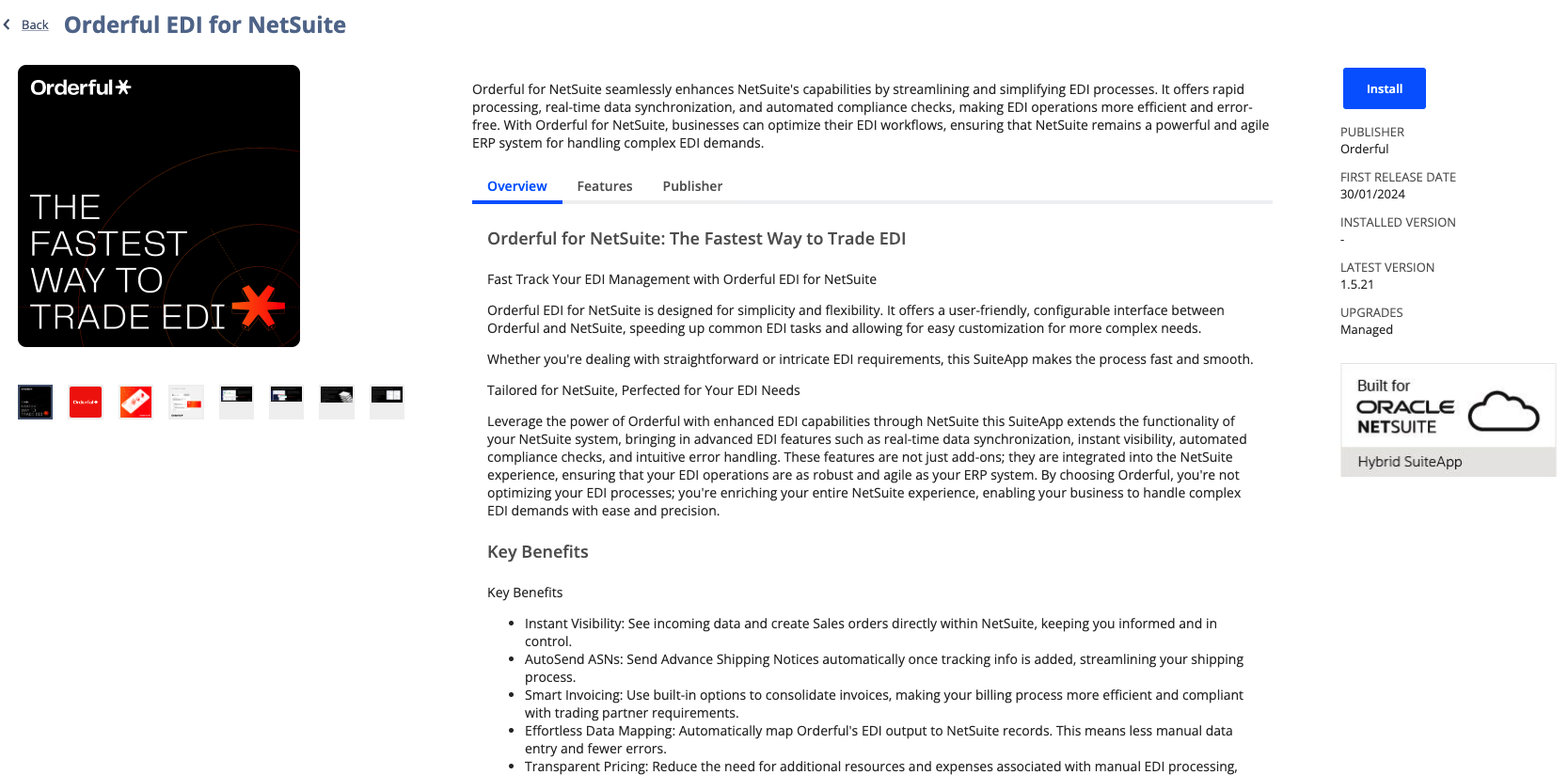Orderful for NetSuite
Overview
Orderful For NetSuite is a SuiteApp that natively connects the Orderful EDI platform to NetSuite. This document covers the steps required to install, configure, and test the connector.
Currently Orderful for NetSuite supports the following EDI documents:
- Inbound Transactions
- 850 Purchase Order -> NetSuite Sales Order
- 875 Grocery Products Purchase Order -> NetSuite Sales Order
- Outbound Transactions
- NetSuite Sales Order -> 855 Purchase Order Acknowledgment
- NetSuite Item Fulfillment -> 856 Advance Ship Notice
- NetSuite Invoice -> 810 Invoice
- Outbound Other
- Scheduled NetSuite Process -> 846 Inventory Advice
- Read Only and Custom Process
- All supported EDI document types
FeaturesRead details on full feature set
The SuiteApp communicates with Orderful via a Poller Communication Channel that syncs data every 15 minutes.
Installing Orderful for NetSuite
Pre-requisites
Before you install the Orderful SuiteApp, you should have:
- A NetSuite account
- Completed Orderful onboarding: Getting started as a Follower
- At least one Relationship
- An Inbound Poller Communication Channel. If you need to create one, we have instructions you can follow.
Installation and Configuration
To install the Orderful SuiteApp:
- Inside your NetSuite instance, navigate to the SuiteApps Marketplace and search for “Orderful”.
- Open the “Orderful EDI for NetSuite” SuiteApp and click the Install button.

Next you will configure the SuiteApp.
Add Orderful API credentials
Begin by copying your Orderful API credentials into your SuiteApp settings:
- Inside Orderful: Go to your Orderful org’s API Credentials page: https://ui.orderful.com/settings/api-credentials
- Inside Netsuite: Navigate to Setup > Company > API Secrets
- Click on Create New, which will open the “Create New Secret” window.
- Start from the Details tab. Enter a “Name” of your choice.
- For “ID”, enter
_orderful_api. NetSuite will prependcustsecretto this, so the final value will becustsecret_orderful_api. - For “Password” and “Confirm Password”, copy the Orderful API Token from your Orderful Settings. Note that once you enter the value and save, you will not be able to access this value.
- On the “Restrictions” tab:
- Enable “Allow for All Scripts”
- Enable “All for All Domains”
- Leave all other options disabled
- Click Save
Configure Global Settings
In NetSuite: Navigate to Setup > Company > General Preferences > Custom Preferences
- Enter your “COMPANY ISA ID” and “TEST ISA ID”
Add Orderful Poller information
- In Orderful: Go to your Communication Channels: https://ui.orderful.com/communication-channels
- Click on the Inbound Poller Communication Channel that you created previously.
- In the pane that opens on the right, you will see a URL with this format:
https://api.orderful.com/v3/polling-buckets/{pollerID}. Copy the ID number at the end of this URL. - Back in Netsuite: Paste this value into the “Polling Bucket ID” in the General section of your Custom Preferences.
- Click Save
(Optional) Add Subsidiary ISA IDs
If using multiple subsidiaries, you are able to assign unique ISA IDs to each.
- In NetSuite: Navigate to Setup > Company > Subsidiaries
- Either create a New Subsidiary or Edit an existing one, as appropriate.
- Enter your Subsidiary's “ISA ID” and “TEST ISA ID”
Contacting Support
For support, please contact [email protected].
Updated 3 months ago
